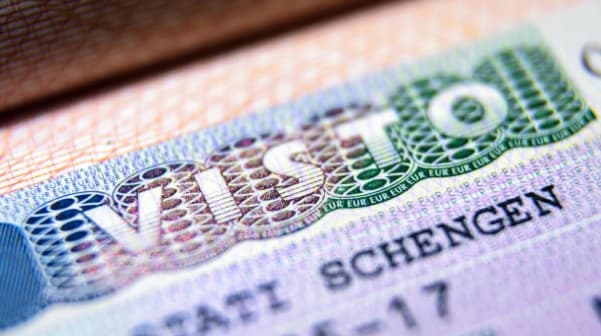Italy welcomes millions of visitors each year, but visa requirements depend on your nationality. If you’re planning to travel in 2026, it’s important to understand the latest Italy visa rules before you go. Travelers from visa-exempt countries can stay in Italy for up to 90 days, though ETIAS authorization will be required once implemented across the Schengen Area.
Visitors from non-visa-exempt countries, including India, must apply for a Schengen visa for Italy in advance. Preparing the required documents early helps ensure a smooth application and stress-free travel experience.
Do You Need a Visa to Go to Italy – In A Nutshell
Italy’s visa requirements vary depending on your citizenship and the duration of your travel.
- EU/EEA citizens do not require a visa and can enter the country freely.
- Citizens of the USA, UK, Canada, and Australia can enter visa-free for up to 90 days for tourism or business.
- Travelers from non-exempt countries (like India, Pakistan, and China) require a short-stay Schengen visa.
- Anyone staying in the country for more than 90 days, traveling for work, or pursuing studies must apply for a long-stay national visa.
- Transit passengers may need a transit visa depending on their nationality.
Which Countries Are Visa-Free For Italy Travel
Many nationalities enjoy visa-free access to Italy thanks to the Schengen Agreement.

Major visa-exempt countries include the United States, the United Kingdom, Canada, Australia, New Zealand, Japan, South Korea, Singapore, Malaysia, and most countries in South America, such as Brazil and Argentina.
Travelers can spend up to 90 days in the country during any 180 days. This stay can be for purposes like tourism, attending business meetings, or visiting family.
The Schengen Agreement allows for travel across 26 countries with a single visa. From 2026, visa-exempt travelers visiting European Countries will be required to obtain ETIAS approval, which will cost approximately $8.
Who Must Apply For An Italian Visa Before Travel (Eligibility)
Citizens from numerous countries must obtain a visa before traveling to Italy.
Countries requiring visas to travel to Italy include India, China, Pakistan, Bangladesh, Nigeria, Turkey, Russia, and most nations in Africa and Asia.
| Visa Category | Countries | Requirement |
|---|---|---|
| Visa-Free | USA, UK, Canada, Australia | No visa needed (up to 90 days) |
| Schengen Visa Required | India, China, Pakistan, Turkey | Short-stay visa mandatory |
| Transit Visa | Some nationalities | Required for airport layovers |
Exceptional circumstances, such as diplomatic passports, refugee travel documents, or specific bilateral agreements, may alter these requirements; therefore, always verify with the nearest Italian consulate.
If you’re interested in exchange programs, check out our guide on what is a J-1 visa to learn more about this visa type.
Types of Italy Visas Explained
Italy offers several visa categories depending on your travel purpose and duration.
Schengen Visa (Type C)
This visa permits stays of up to 90 days in Italy and the entire Schengen Area, making it suitable for tourism, business, or family visits.
The Schengen Visa fee for adults is about $94.50, while children aged 6 to 12 pay around $50. Additional service fees may apply depending on the application center.
National Visa (Type D)
This visa is required for stays longer than 90 days, such as for work, study, family reunification, or long-term residence. It allows you to live in Italy and apply for a residence permit.
The fee usually ranges from $120 to $130, depending on the consulate.
Student Visa (Type D – Study)
Intended for students enrolling in courses longer than 90 days, this visa requires proof of admission and financial means.
The fee typically ranges between $50 and $70, depending on the consulate and exchange rates. It also allows applying for a residence permit after arrival.
Airport Transit Visa (Type A)
This visa is for travelers transiting through Italian airports to non-Schengen destinations without entering Italy.
The fee is about $99 per person. Children aged 6 to 12 pay roughly half that amount, around $50.
For those interested in U.S. immigration options, check out our detailed guide on what is a Diversity Visa to understand this unique visa program.
How to Apply For an Italian Visa: Step-by-Step Process
The Italian visa application process involves several straightforward steps that require careful preparation.

Step 1: Check Visa Type And Eligibility
Determine if you need a Schengen or National Visa based on your nationality and travel purpose.
Step 2: Fill Out the Visa Application
Complete the online visa application form with accurate and complete information.
Step 3: Schedule an Appointment
Book an appointment at the nearest Italian consulate or authorized visa center.
Step 4: Gather and Submit Documents
Collect all required documents like a passport, photos, insurance, and financial proof, and submit them as instructed.
Step 5: Pay Fees and Attend Interview
Pay the visa fee and attend an interview, if required by the consulate.
Step 6: Track and Receive Your Visa
Monitor your application status online and collect your passport once your visa is approved.
How Long Does It Take For an Italian Visa To Get Approved?
Italian visa processing times vary depending on the visa type and your nationality.
Schengen visas typically take around 15 working days but can be extended up to 45 days in exceptional cases.
National visas to Italy (for work, study, or extended stays) may take up to 90 days to process.
To avoid delays, it’s best to apply well in advance of your intended travel date, especially for long-term stays.
Required Documents For an Italy Visa
Proper documentation is essential for a successful Italian visa application.
- Valid passport: Your passport must be valid for at least 3 months after your intended departure and have at least two blank pages.
- Visa application form: The application form must be fully completed, signed, and include a recent passport-size photograph.
- Photographs: Submit two recent passport-size color photos with a white background, taken within the last six months.
- Proof of accommodation and return travel: Provide hotel bookings, rental agreements, or invitation letters along with confirmed round-trip flight tickets.
- Travel insurance: You must have travel insurance that covers medical emergencies and is valid throughout the entire Schengen Area.
- Financial proof: Submit recent bank statements, employment letters, or sponsorship documents showing you can fund your trip.
- Supporting letters: Include relevant documents, such as employment verification, student enrollment records, or invitations from hosts in Italy.
Did you know? Italy holds the 5th position among the top 15 countries with the strongest passports in the world.
Travel Tips for Italy Visa Applicants
Thoughtful preparation can significantly improve your visa application success rate and overall experience.
- Apply well in advance.
Submit your application 3–6 weeks before your travel date to avoid delays and allow time for extra document requests.
- Always check the latest updates.
Visa rules can change, so confirm current requirements with your nearest Italian embassy or consulate before applying.
- Double-check the document checklist.
Requirements may vary slightly by consulate, and missing documents are a common cause of delays or rejections.
- Keep copies of everything during travel.
Carry photocopies of your passport, visa, insurance, and other key documents separately from the originals while traveling.
Consider applying through authorized visa centers rather than directly at embassies, as they often provide better customer service and shorter waiting times for a small additional service fee.
What is ETIAS and How Will It Affect Travelers to Italy?
The European Travel Information and Authorization System, or ETIAS, is a new online travel authorization launching in 2026 for visitors from visa-exempt countries traveling to Italy and other Schengen Area countries.
While these travelers currently don’t need a visa for short stays, from 2026 onward, they must apply for ETIAS before their trip. The process is simple and quick, involving an online form and a small fee.
ETIAS aims to improve security by screening travelers before arrival, helping to:
- Identify potential security risks early
- Prevent the entry of individuals with serious criminal records
- Enhance border safety across Europe
Once approved, ETIAS is valid for three years and allows multiple entries, making travel easier for frequent visitors. It’s important to apply well ahead of your trip to avoid any delays or travel disruptions.
ETIAS Fee and Validity
The ETIAS authorization will cost around €7 for travelers aged 18–70.
Once approved, it remains valid for 3 years or until your passport expires, whichever comes first, and allows multiple entries into Italy and the Schengen Area.
ETIAS vs Schengen Visa: What’s the Difference?
| Feature | ETIAS | Schengen Visa |
|---|---|---|
| For whom | Visa-exempt travelers | Travelers who need a visa |
| Application type | Online | Embassy/Consulate |
| Processing time | Minutes to a few days | Up to 15 days |
| Validity | 3 years | Usually up to 90 days |
When Will ETIAS Start?
ETIAS is expected to launch officially in 2026. Travelers visiting Italy after that date must apply before boarding their flight or entering through land borders.
Travel Insurance Requirements for Italy 2026
Travel insurance is mandatory for Schengen visa applicants and highly recommended for all travelers to Italy. It must cover medical expenses, hospitalization, and repatriation for the entire duration of your stay.
Key Points:
- Minimum coverage: €30,000.
- It should be valid for all Schengen countries during your trip.
- Covers emergencies like accidents, illness, or flight cancellations.
- Applying for insurance early can speed up visa approval.
Driving in Italy With a Foreign License
Short-term visitors to Italy can legally drive using a valid foreign driver’s license, including a U.S. license. While some European countries require an International Driving Permit (IDP), Italy does not mandate an IDP for short stays if the license is valid.
Travelers planning to live or stay long-term in Italy may need to convert their foreign license to an Italian driving license, depending on residency rules.
Vaccination Requirements for Travel to Italy
Italy does not have any mandatory vaccination requirements for travelers entering the country. However, international travelers are advised to be up to date with routine vaccinations, as recommended by health authorities.
Before departure, it is always wise to consult a healthcare provider for personalized medical advice, especially if you have pre-existing conditions or are planning an extended stay.
Healthcare Coverage and Travel Insurance in Italy
- Public healthcare benefits from your home country are not valid in Italy
- Medical expenses may need to be paid upfront without travel insurance
- Travelers are advised to carry valid travel medical insurance for Italy
- Insurance should cover emergency treatment, hospitalization, and evacuation
- Travel insurance is often mandatory for Schengen visa applications
Suggested Reads:
Final Thoughts: Know Italy’s Visa Rules Before You Travel in 2026
Whether you need a visa to visit Italy depends on your nationality and the length of your stay. Travelers from visa-exempt countries can enter Italy for short visits without a traditional visa; however, starting in 2026, they will be required to obtain an ETIAS travel authorization before departure. ETIAS is not a visa but a pre-travel authorization that allows multiple short stays within the Schengen Area.
For travelers from non-visa-exempt countries, including India, a Schengen visa for Italy remains mandatory. Since Italy is part of the Schengen Area, a single visa allows travel to multiple European countries within the permitted stay period. To avoid delays, always review the latest entry rules and prepare your documents in advance.
FAQs
Visa-free travelers cannot extend their 90-day Schengen stay and must leave for at least 90 days before returning visa-free.
Transit visa requirements depend on your nationality and whether you leave the airport’s international zone during your layover.
Tourist visas prohibit employment; you need a specific work visa or permit to work legally in Italy.
Rejections include reasons, and you may reapply after addressing issues or appeal within the specified timeframe.
U.S. citizens can stay in Italy visa-free for 90 days. Watch out for pickpockets, fines, and rules on monuments and drones.
An Italian passport lets holders enter 188+ countries visa-free or with visa-on-arrival, including the EU, U.S., Canada, Japan, and UAE.



